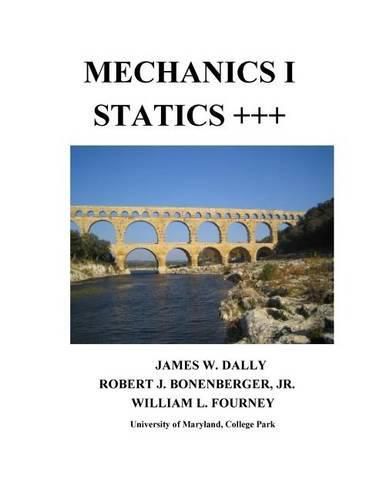Readings Newsletter
Become a Readings Member to make your shopping experience even easier.
Sign in or sign up for free!
You’re not far away from qualifying for FREE standard shipping within Australia
You’ve qualified for FREE standard shipping within Australia
The cart is loading…






This title is printed to order. This book may have been self-published. If so, we cannot guarantee the quality of the content. In the main most books will have gone through the editing process however some may not. We therefore suggest that you be aware of this before ordering this book. If in doubt check either the author or publisher’s details as we are unable to accept any returns unless they are faulty. Please contact us if you have any questions.
The content of the Mechanics I textbook includes methods for determining stresses and strains in uniaxial members, column buckling loads, and a discussion of material properties and material behavior. Because we have included three topics not normally found in traditional Statics books, we have added the three plus signs to the subtitle Statics +++.
We introduced the concept of stresses in uniaxial members, because an analysis of the forces in some structural element is incomplete. Determining the force is not sufficient to establish the safety of the structural member or to design its cross section. However, it is easy to introduce stresses in uniaxial members s = P/A, and we have taken this important step toward a more complete analysis. Next, we added a chapter on materials and material properties introducing yield and ultimate tensile strength. Determining the stress and comparing this value with the strength of an engineering material enables the student to establish the safety factor or the margin of safety of the structural element. We have found that extending the analysis to incorporate safety and/or design improves the student’s interest and motivation.
We often include a project that involves student teams building a model of a truss, which is subsequently tested in the laboratory. The students perform a truss analysis and predict the failure load of their model. In testing the models, we found that compression members on many of the trusses failed at loads much lower than the values predicted by the student teams. These compression members were buckling at relatively low loads, while the stresses were lower than the strength of the model material. This laboratory experience enabled us to discuss elastic instability and to demonstrate buckling. We have added a chapter on Euler (elastic) buckling to this edition to enable the student to study and to begin to understand elastic instability in structures.
$9.00 standard shipping within Australia
FREE standard shipping within Australia for orders over $100.00
Express & International shipping calculated at checkout
This title is printed to order. This book may have been self-published. If so, we cannot guarantee the quality of the content. In the main most books will have gone through the editing process however some may not. We therefore suggest that you be aware of this before ordering this book. If in doubt check either the author or publisher’s details as we are unable to accept any returns unless they are faulty. Please contact us if you have any questions.
The content of the Mechanics I textbook includes methods for determining stresses and strains in uniaxial members, column buckling loads, and a discussion of material properties and material behavior. Because we have included three topics not normally found in traditional Statics books, we have added the three plus signs to the subtitle Statics +++.
We introduced the concept of stresses in uniaxial members, because an analysis of the forces in some structural element is incomplete. Determining the force is not sufficient to establish the safety of the structural member or to design its cross section. However, it is easy to introduce stresses in uniaxial members s = P/A, and we have taken this important step toward a more complete analysis. Next, we added a chapter on materials and material properties introducing yield and ultimate tensile strength. Determining the stress and comparing this value with the strength of an engineering material enables the student to establish the safety factor or the margin of safety of the structural element. We have found that extending the analysis to incorporate safety and/or design improves the student’s interest and motivation.
We often include a project that involves student teams building a model of a truss, which is subsequently tested in the laboratory. The students perform a truss analysis and predict the failure load of their model. In testing the models, we found that compression members on many of the trusses failed at loads much lower than the values predicted by the student teams. These compression members were buckling at relatively low loads, while the stresses were lower than the strength of the model material. This laboratory experience enabled us to discuss elastic instability and to demonstrate buckling. We have added a chapter on Euler (elastic) buckling to this edition to enable the student to study and to begin to understand elastic instability in structures.